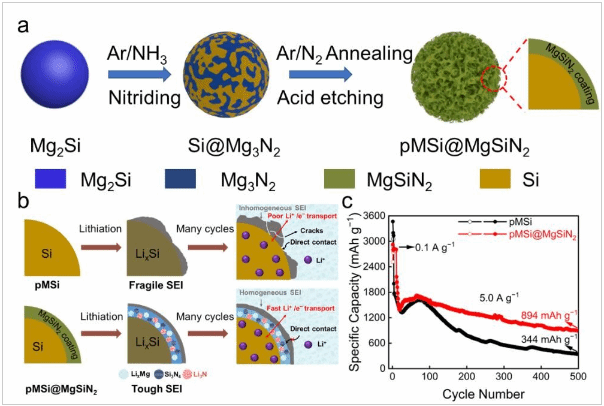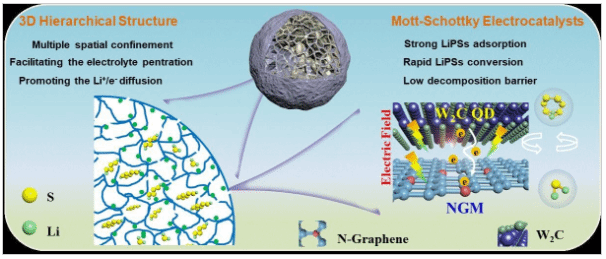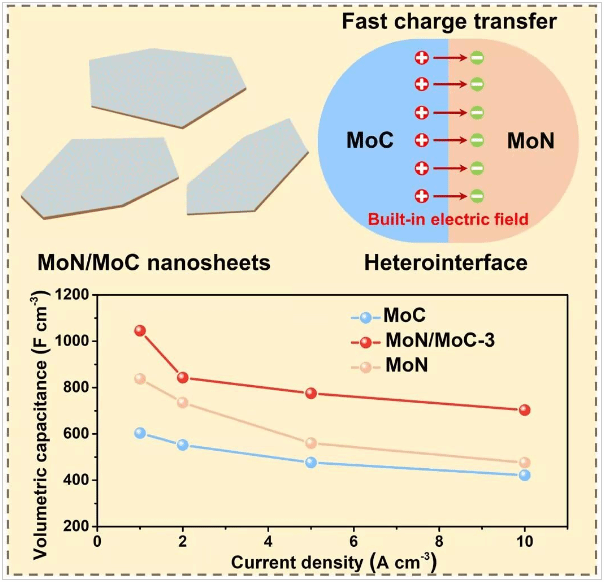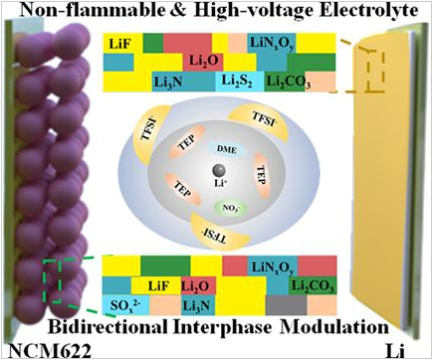Published by: Advanced Materials and Nano-technology Research Institute
Edited by: Cheng Yu
WUST News A series of significant research advancements have been made by the team of Professor Huo Kaifu from the State Key Laboratory of Refractories and Metallurgy and the Advanced Materials and Nano-technology Research Institute of the WUST. These developments pertain to advanced energy materials and energy storage technologies, including:
1. Advanced Energy Materials, 2024, 14, 2303876. (IF: 27.8)
2. Energy Storage Materials, 2024, 103416. (IF: 20.4)
3. Advanced Functional Materials, 2023, 2306115. (IF: 19.0)
4. Advanced Functional Materials, 2023, 13, 2311040. (IF: 19.0)
5. ACS Nano, 2023, 17, 23, 24227-24241. (IF: 17.1)
To address the huge stress problem caused by the large volume change of the alloy-type anode material during the cycling process, the team designed and prepared three-dimensional micro-nano hierarchical porous germanium (p-Ge) based on their previous work on three-dimensional ant nest-like porous silicon (Nature Communications, 2019, 10, 1447). This material has a micro-nano hierarchical structure with the advantages of large capacity, short lithium-ion diffusion path, and reduced volume expansion. Through in-situ/semi-in-situ experimental characterisation methods and theoretical calculations, the lithium storage mechanism and stress dispersion behaviour of micro-nano hierarchical porous germanium have been elucidated.
This work provides new insights into the design of high performance, low volume expansion alloy anodes. The research has been published in the leading international energy journal Advanced Energy Materials (IF: 27.8). Doctoral student Guo Siguang is the first author of the paper, and Professor Huo Kaifu and Professor Gao Biao are the corresponding authors.

Figure 1. Schematic Diagram of the Electrochemical Lithium Storage Advantages and Service Mechanism of Micro-Nano Hierarchical Porous Ge
Aiming at the problems of low ionic conductivity and unstable interface on the surface of porous silicon, the research team designed an MgSiN2 functional layer on the surface of porous silicon, and in-situ constructed a high ionic conductivity Li3N and Li-Mg alloy composite interface on the surface of porous silicon during the charging and discharging process, which enhanced the ionic conductivity and structural stability of the porous silicon interface, improved its electrochemical lithium storage performance. Through in-situ/semi-in-situ experimental characterization methods, the electrochemical conversion mechanism of the MgSiN2 functional layer was revealed.
This work provides a new approach to the interface design of silicon-based anode materials. Related research has been published in the leading international journal Energy Storage Materials (IF: 20.4) in the field of energy and materials science. PhD student Xiang Ben and junior faculty member Dr Liu Yu are the first authors of the paper, and Professor Huo Kaifu and Professor Gao Biao are the corresponding authors.

Figure 2. Synthesis and Service Mechanism Diagram of pMSi@MgSiN2 and Lithium Storage Performance
Addressing the problems of polysulfide shuttle and slow reaction kinetics in lithium-sulfur batteries, the research team designed a novel three-dimensional hierarchical Mott-Schottky electrocatalyst that exploits the multiple spatial confinement effect of carbon to inhibit LiPS shuttle, and the Mott-Schottky electrocatalyst and spontaneous charge reconstruction to enhance reaction kinetics.
This achievement has been published in the top international journal Advanced Functional Materials (IF: 19.0). PhD student Luo Rongjie is the first author of the paper, and Professor Huo Kaifu and Professor Zheng Yang are the corresponding authors.

Figure 3. Mechanism Diagram of Mott-Schottky Electrocatalyst Enhancing Sulfur Electrochemical Conversion
MoN and MoC are typical metal nitrides and carbides. However, the controllable preparation and pseudocapacitive storage performance of two-dimensional in-plane MoC/MoN heterojunctions have not been reported yet. The research team developed a molten salt-assisted synthesis method for the controllable preparation of two-dimensional MoC/MoN nanosheets, andinvestigated the capacitance performance of MoC/MoN by in-situ infrared, Raman spectroscopy, and quartz crystal microbalance. It was shown that the pseudocapacitance of MoC/MoN is due to the insertion and extraction of hydrogen ions and Mo-N, providing theoretical guidance for the design of high performance transition metal nitride electrode materials.
The research has been published in the leading international journal Advanced Functional Materials (IF: 19.0). Master student Wang Cheng is the first author, and Professor Huo Kaifu is the corresponding author.

Figure 4. Schematic Diagram of In-Plane Heterojunction and Interface Interaction of Two-Dimensional MoC/MoN and Corresponding Volumetric Capacity
Addressing the problem that the commercial carbonate-based electrolyte has poor compatibility with the highly active lithium anode and high-voltage cathode, resulting in battery failure and even safety accidents, the research team proposed a strategy of dual additives of DME and LiNO3 to regulate the solvation structure and form a stable electrode-electrolyte interface on the surface of the positive and negative electrodes, effectively inhibiting the side reactions between the electrode and the electrolyte during the electrochemical process.
This research has been published in the top international journal ACS Nano (IF: 17.1). PhD student Guo Qifei is the first author, and Professor Huo Kaifu and Professor Zheng Yang are the corresponding authors.

Figure 5. Schematic Diagram of Bidirectional Regulation of Positive and Negative Electrode Interfaces by Safe and High-Voltage Electrolytes
For the above series of achievements, the State Key Laboratory of Refractories and Metallurgy of the WUST is the first unit of the paper. The relevant links of the paper are as follows:
1. https://doi.org/10.1002/aenm.202303876
2. https://doi.org/10.1016/j.ensm.2024.103416
3. https://doi.org/10.1002/adfm.202306115
4. https://doi.org/10.1002/adfm.202311040
5. https://doi.org/10.1021/acsnano.3c09643